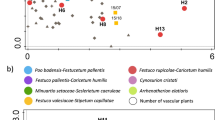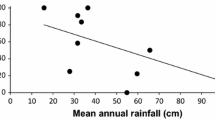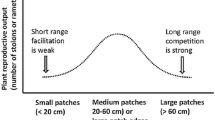Abstract
Longterm (45 years) temporal data were used to assess the influence of spatial scale on temporal patterns of a semi-arid west Texas grassland. Temporal basal area dynamics of common curlymesquite (Hilaria belangeri (Steud.) Nash) collected from permanent plots within two areas that were released from disturbance (longterm overgrazing and drought), were evaluated at two spatial scales (quadrat, site). Wiens (1989) proposed hypotheses to characterize the influence of scale on variability, predictability, and equilibrium. These hypotheses were tested for this grassland and temporal patterns observed were different for each spatial scale. The large scale (site) was characterized by low variation between units, high variation within units, high potential predictability, and possible movement toward a fluctuating but relatively stable or equilibrial state. At the small scale (quadrat), variation between units was high, predictability low, and there was no indication of movement toward a stable state; chaotic behavior may be expressed at this scale although the length of the temporal record may not be sufficient to evaluate this phenomenon.
Similar content being viewed by others
References
Bedward, M., Keith, D.A. and Pressey, R.L. 1992. Homogeneity analysis: Assessing the utility of classifications and maps of natural resources. Aust. J. Ecol. 17: 133–139.
Butler, J.L. and Briske, D.D. 1988. Population structure and tiller demography of the bunchgrassSchizachyrium scoparium in response to herbivory. Oikos 51: 306–312.
Carlile, D.W., Skalski, J.R., Batker, J.E., Thomas, J.M. and Cullinan, V.I. 1989. Determination of ecological scale. Landscape Ecology 2: 203–213.
Costanza, R. and Maxwell, T. 1994. Resolution and predictability: An approach to the scaling problem. Landscape Ecology 9: 47–57.
Crawley, M.J. 1990. The population dynamics of plants.In Population Regulation and Dynamics, Proc. A Royal Society Discussion Meeting. Phil. Trans. R. Soc. Lond., G. Britain. Edited by M.P. Hassell and R.M. May.
Cullinan, V.I. and Thomas, J.M. 1992. A comparison of quantitative methods for examining landscape pattern and scale. Landscape Ecology 7: 211–227.
Gleick, J. 1987. Chaos: Making a new science. Viking. New York, New York, USA.
Greg-Smith, P. 1964. Quantitative plant ecology. Second edition. Butterworths, London, England.
Hastings, A., Ham, C.L., Ellner, S., Turchin, P. and Godfray, H.C.J. 1993. Chaos in ecology: Is mother nature a strange attractor? Ann. Rev. Ecol. Syst. 24: 1–33.
Hatch, S.L., Ghadi, K.N. and Brown, L.E. 1990. Checklist of the Vascular Plants of Texas. TX Agr. Exp. St. MP-1655, College Station TX.
Klijn, F. and Udo de Haes, H.A. 1994. A hierarchical approach to ecosystems and its implications for ecological land classification. Landscape Ecology 9: 89–104.
Levin, S.A. 1992. The problem of pattern and scale in ecology. Ecology 73: 1943–1967.
Menge, B.A. and Olson, A.M. 1990. Role of scale and environmental factors in the regulation of community structure. Trends in Ecology and Evolution 5: 52–57.
O'Neill, R.V., DeAngelis, D.L., Waide, J.B. and Allen, T.F.H. 1986. A hierarchical concept of ecosystems. Princeton University Press, Princeton, New Jersey, USA.
O'Neill, R.V., Johnson, A.R. and King, A.W. 1989. A hierarchical framework for the analysis of scale. Landscape Ecology 3: 193–205.
O'Neill, R.V., Turner, S.J., Cullinan, V.I., Coffin, D.P., Cook, T., Conley, W., Brunt, J., Thomas, J.M., Conley, M.R. and Gosz, J. 1991. Multiple landscape scales: An intersite comparison. Landscape Ecology 5: 137–144.
Rahel, F.J. 1990. The hierarchical nature of community persistence: a problem of scale. Amer. Natur. 136: 328–344.
Schaffer, W.M. and Kot, M. 1985. Do strange attractors govern ecological systems. Bioscience 35: 342–350.
Smeins, F.E., Taylor, T.W. and Merrill, L.B. 1976. Vegetation of a 25 year exclosure on the Edwards Plateau, Texas. J. Range. Manage. 29: 24–29.
Smeins, F.E. and Merrill, L.B. 1988. Longterm change in a semi-arid grassland.In Edwards Plateau vegetation: plant ecological studies in central Texas. Baylor University Press. Waco, Texas, USA. Edited by B.B. Amos and F.R. Gelbach.
Sugihara, G. and May, R.M. 1990. Applications of Fractal Ecology. Trends in Ecology and Evolution 5: 79–86.
Tilman, D. and Wedin, D. 1992. Oscillations and chaos in the dynamics of a perennial grass. Nature 353: 653–655.
Turner, M.G. 1990. Spatial and temporal analysis of landscape pattern. Landscape Ecology 4: 21–30.
Turner, S.J., O'Neill, R.V., Conely, W., Conely, M.R. and Humphries, M.R. 1992. Pattern and scale: statistics for landscape ecology.In Quantitative Methods in Landscape Ecology. Springer-Verlag, New York. NY. Edited by M. Turner and R.H. Gardner.
Wiens, J.A. 1989. Spatial Scaling in ecology. Functional Ecology 3: 385–397.
Author information
Authors and Affiliations
Rights and permissions
About this article
Cite this article
Fuhlendorf, S.D., Smeins, F.E. Spatial scale influence on longterm temporal patterns of a semi-arid grassland. Landscape Ecol 11, 107–113 (1996). https://doi.org/10.1007/BF02093742
Issue Date:
DOI: https://doi.org/10.1007/BF02093742




